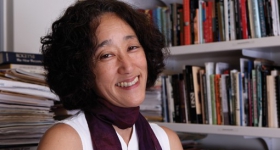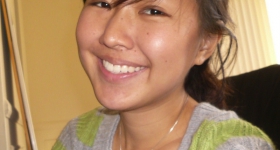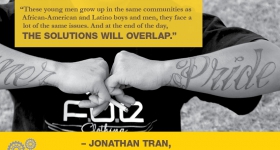Originally published at New America Media.
This project is a collaboration of New America Media, San Francisco Chronicle and KTSF Television. The story cannot be reprinted without permission.
Video by Vivian Po and Angelina Wong
Joe Johnson and Nelson Liang grew up on opposite sides of the world -- Arkansas, USA, and Guangzhou, China, respectively. They’ve ended up working within feet of each other, on San Francisco’s San Bruno Avenue, where they share a view of a rapidly changing neighborhood and a prescription for improving relations between African American and Asian American communities.
It’s not exactly rocket science: People need to get to know each other and understand their cultural differences and similarities. Their prescription might seem obvious, but the fact that it springs from their day-to-day, on-the-street experiences gives it weight. And a reassuring sense of possibility.
I met Johnson and Liang during a reporting trip with this project’s partners to explore the diversity of San Bruno Avenue. Johnson, who is African American and owns a barbecue restaurant, and Liang, the Chinese American owner of a hair salon, agreed to talk to us about their neighborhood and how they ended up there.
Each started a business on the avenue in the ’90s, Johnson in 1994 and Liang in 1998. They had the same motivation -- each noticed a void that translated into opportunity. Liang saw the growing Asian population and no Chinese-owned barbershop. Johnson figured the area could use a barbecue restaurant. They also were attracted by the affordable real estate and rent. “I really didn’t look any place else,” Johnson said. He’s a young-looking 70 and wore a Johnson Barbecue T-shirt that proclaimed, “You can eat my meat with no teeth.” A hand-painted sign advertises his Thermo Nuclear sauce. “It’s hot, but tasty,” Johnson advises.
Liang, interviewed in Cantonese with an English translator, came to the United States in 1990 at 28, with lots of energy. He worked hard at lots of jobs -- “working as a cow in the morning and sleeping like a pig at night,” he said. He realized he needed a skill and trained as a barber. Since he opened his shop on San Bruno Avenue, the Asian population has grown steadily. According to the recent census, since 2000, the Asian population of supervisorial District 10 has increased by nearly 16 percent, to 60 percent.
“It’s still very diverse,” he said. “Mexicans, Filipinos, Vietnamese. You can hear lots of languages if you walk on the street. We’re very used to a diverse community. Some of the new immigrants aren’t so used to it.”
In fact, Johnson and Liang seem to thrive on the cultural mix. Liang said he is impressed by the non-Chinese patrons of the avenue’s dim sum restaurants who are proficient in using chop sticks. Johnson seemed amazed by the people who come in to eat his Thermo Nuclear sauce and “turn red as a beat, and start sweating.” Liang recalled the first African American customer to come to his shop.
“I was worried because I never did their hairstyle before. I didn’t know if I was sophisticated enough to do her hair. But I did good. She kept coming back.”
Johnson said he has a large Asian clientele. “I’d like to have the menu in Cantonese and signs in the windows in Cantonese,” he said. “A lot of Asians don’t speak English and wouldn’t know what to ask for.”
If they do, he observed, they’ll find similarities to Chinese cuisine -- barbecue, and pork and greens, for example. Johnson pointed out that his doctor, who is Chinese, advises him to limit his consumption of both African American and Chinese cuisine. At his restaurant, a young Burmese kid was working in the kitchen. Four young Asian men came in and ordered barbecue.
“It’s a very friendly area,” Liang said. “There are very few conflicts. But I don’t think we have enough communication. I think Chinese people are not open enough to strangers. It’s harder for us to reach out, especially for new immigrants, because of the language barriers.”
As an example, he said people used to be leery of an African American man who walks along the avenue carrying a boom box. “He said ‘Hi’ every time he saw me. Since then, we’ve made friends,” Liang said.
Johnson, who retired after 46 years as an administrator with the city Department of Public Works, said many of his employees were Asian; several come by the restaurant to visit. A friend of about 30 years, Steve, is Chinese.
“Chinese and African Americans don’t take time to get to know each other. We don’t recognize the different cultural upbringing. It goes both ways,” Johnson said. “I was in a shop today, and a lady didn’t speak English, but she was trying. I said, if we go to China, they’ll say the same thing about us.”
Liang suggested leaders work to build a bridge between the communities.“For us everyday people, it’s hard to do anything. Leaders should start that for the communities.”
Are Chinese residents afraid of African Americans? “Not afraid, but distant, partly because of language barriers, but also because the cultures are different. They’re not used to them.”
Johnson said the groups need to socialize more. “We could have block parties. If we took the time to get to know each other, well, the world would be much better off.”
So that’s the recommendation from two small businessmen navigating the changes on San Bruno Avenue -- social interaction between ethnic communities.
And a parking garage.
Brenda Payton is an East Bay writer. This project is a collaboration of the San Francisco Chronicle/SFGate.com; KTSF Television, a local Asian language station; and New America Media, the nation’s first and largest network of ethnic news services. The participants launched the project with the idea that people telling each other their stories would encourage communities to talk about common goals. The text and a video are in English and Chinese. KTSF will air its Chinese-language news reports on Monday night on Channel 26 (cable channel 8) at 7 or 12 p.m. (Cantonese News) and 10 p.m. (Mandarin News).
To view the video of Joe Johnson and Nelson Liang in Chinese on KTSF, please visit: www.ktsf.com
To read the story on the San Francisco Chronicle, please visit: www.sfgate.com/opinion









Comments